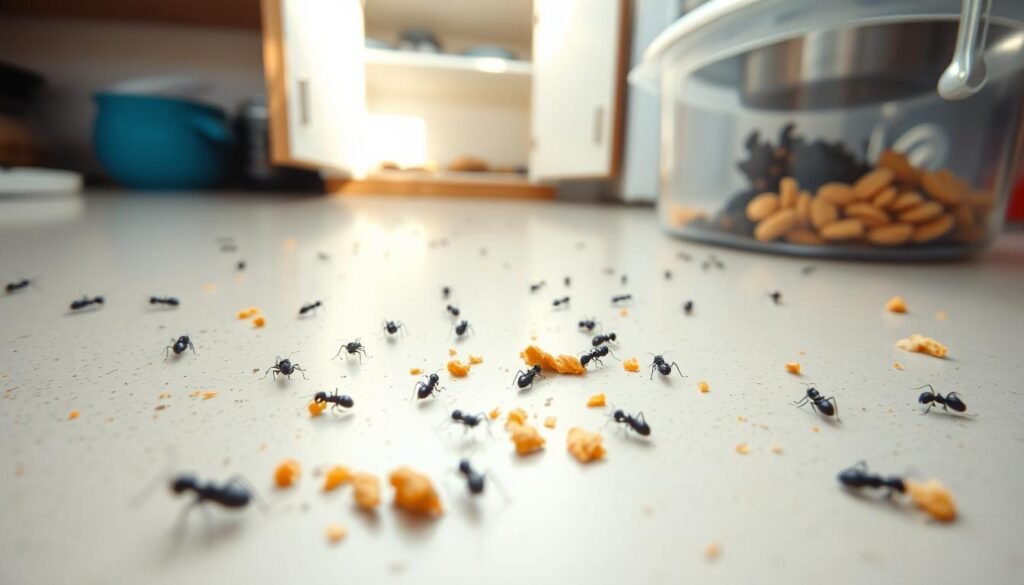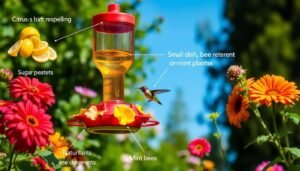Every summer, flying ants surprise me, especially in July and August. They show up when it’s hot and humid. Many of us ask, why do flying ants suddenly appear? Are they warning us of an infestation or showing where colonies are?
Learning about their swarming helps us understand their biology and how they reproduce. It also shows how they interact with their surroundings.
Key Takeaways
- Flying ants typically swarm during July and August.
- The emergence of flying ants correlates with warm and humid weather conditions.
- Swarming happens over several weeks, not just on a single day.
- Lasius niger is the most commonly observed flying ant species in urban areas.
- Both temperature and humidity are crucial triggers for mating flights.
- Understanding their patterns helps distinguish between flying ants and termites.
Table of Contents
Understanding Flying Ants
Flying ants are important for their colony’s future. They have wings and help with reproduction. In cities, like black garden ants, are common during swarming season.
What Are Flying Ants?
Flying ants appear in spring and summer. They swarm, which means more are seen inside. They don’t bite but look for food and water to help their colony.
If you see one inside, it might have come in through an open door or window.
Life Cycle of Ants
The life cycle of ants starts with the queen laying eggs. These eggs turn into larvae, then pupae, and finally adult ants. This cycle keeps the colony healthy.
During mating, female ants fly and then lose their wings. They look for new places to nest. This happens on warm, clear days.
| Ant Lifecycle Stage | Description |
|---|---|
| Egg | The initial stage where the queen lays her eggs, typically small and white. |
| Larva | Developing stage, where the larva feeds on food provided by worker ants. |
| Pupa | Transformation phase, where the larva develops into an adult ant sometimes in a cocoon. |
| Adult | The mature stage where ants fulfill specific roles such as worker, queen, or male. |
When Do Flying Ants Appear?
Flying ants show up in certain weather conditions. Knowing when they appear helps us manage outdoor spaces better in warm months.
Seasonal Activity of Ants
Flying ants are most noticeable in summer, especially in July or August. This is when it’s hot and humid. Cities see seasonal ant activity sooner than rural areas because of the heat.
The swarming can happen from late June to early September. This shows how different climates affect their timing.
Impact of Weather Conditions
Weather plays a big role in when we see flying ants. They swarm on warm, calm days. This is better than the day before.
There’s no single “flying ant day.” Instead, there’s a flying ant season with several peak times. These swarms help feed birds, supporting the ecosystem.
| Month | Typical Weather Conditions | Ant Species Observed |
|---|---|---|
| June | Warm, humid | Common black ants, red ants |
| July | Hot, clear | Common black ants |
| August | Hot, humid | Common black ants |
| September | Warm, variable | Yard ants of various species |
What Triggers Ant Nuptial Flights?
Ant nuptial flights are a key part of many ant species’ lives. During these flights, winged males and new queens mate. This leads to the start of new colonies. Several things decide when and if these flights happen.
Conditions for Mating Flights
Weather is a big factor in when ants fly to mate. Rain makes it hard for them to fly. So, they need clear skies.
Warm weather and high humidity help ants swarm more. I’ve seen these flights happen in spring or summer. This is often on “Flying Ant Day,” when many queens fly out.
These queens attract predators. So, good weather is very important.
Role of Temperature and Humidity
Temperature is a key signal for ants. Warmer temps mean ants are ready to mate. Humidity is also key. Higher humidity makes flying easier for them.
The right mix of temperature and humidity is crucial. It affects how well these flights go. Since female ants need sperm from many mates, knowing when to fly is key to their survival.
Why Do Flying Ants Suddenly Appear?
Flying ants show up suddenly during their mating season. This is a key part of their life. They fly around in warmer months, especially after summer rains.
Things like temperature and humidity affect their flying. A warm day can make thousands of ants fly, creating amazing sights in the sky.
Signs of Mating Season
When flying ants start showing up everywhere, it’s mating season. Swarms can last about 45 minutes. This is a busy time for ants.
In cities, ants fly earlier because it’s warmer. But, not all ants fly on the same day every year. They often cluster low to the ground while flying, which is really cool to see.
Variability in Swarming Patterns
There are over a dozen ant species in places like Chicago. Each has its own flying time. This means swarming can go on for weeks, not just one day.
Flights can happen in June, July, or even early fall. Sometimes, they happen all year when it’s right. These swarms help the soil and feed wildlife, showing how important they are.
The Role of Ant Swarms in Reproduction
Ant swarms are key to the success of these insects. Flying ants meet in huge numbers during nuptial flights. This boosts their chances of finding mates and ensures genetic diversity.
This approach shows the power of safety in numbers. It also highlights the need to maximize mating chances among flying ants.
Safety in Numbers
Swarming offers protection from predators. Thousands of ants in the sky confuse potential threats. Birds like swifts and gulls feed on flying ants during this time.
By swarming in large groups, ants increase their survival chances. This lets more ants focus on reproducing, not just avoiding predators.
Maximizing Mating Opportunities
The timing of swarming is crucial. Flying ant swarms happen in July or August, when it’s hot and humid. This weather helps both queen and male ants to mate.
It lets males from this season mate with queens from different colonies. This is important for avoiding inbreeding. It also helps queens start new nests, which can grow into large colonies of 5,000 to 15,000 worker ants.
Identifying Flying Ants vs. Termites

It’s key to tell flying ants from termites for good pest control. They look different, but knowing common characteristics helps. Their nests also show big differences.
Common Characteristics
Flying ants have a thin waist and bent antennae. Their front wings are longer than their back wings. Termites have a straight body and equal-sized wings. This makes them easy to tell apart.
| Feature | Flying Ants | Termites |
|---|---|---|
| Body Shape | Narrow waist, tapered appearance | Uniform, straight body |
| Antennae | Elbowed | Straight |
| Wing Length | Forewings longer than hind wings | Wings equal in length |
| Typical Lifespan | Workers: months; Queens: a few years | Workers: years; Queens: decades |
Differences in Nesting Behavior
Looking at how they nest helps too. Flying ants like wet or damp wood. But they can also live in dry wood. This can harm buildings over time.
Termites prefer moist, rotting wood. They often live in houses, causing damage for years. Knowing these habits helps fix pest problems.
What Happens After the Nuptial Flight?
After the nuptial flight, big changes happen in flying ants’ lives. The mated queen becomes the leader of a new colony. Her role is key for the colony’s survival and growth.
Life of a Mated Queen
The mated queen starts her new life after mating. She chews off her wings and looks for a place to start her colony. This is when she becomes the founder of a new colony.
She lays her first eggs and takes care of them. This is the start of a new generation of worker ants. It’s important for the colony’s growth.
Formation of New Colonies
The queen’s ability to adapt is crucial for a new colony. At first, she’s alone, using her stored food until workers hatch. When workers grow up, they start foraging.
This lets the queen focus on making more ants. The workers do many jobs, helping the colony grow. With good food and shelter, the colony can thrive.
Signs of an Ant Infestation

Ant infestations show up in many ways. Knowing these signs early helps take action fast. This prevents the problem from getting worse.
Common Indicators of Infestation
Seeing winged ants inside is a big sign. It means a big ant colony might be near. Other signs include:
- Discarded wings: Finding wings near windows or entry points means ants are coming.
- Visible trails: Lines of ants show paths to food, meaning a colony is there.
- Structural damage: Carpenter ants damage wood, especially where it’s wet.
Spotting these signs early helps fix the problem before it costs more.
Role of Carpenter Ants in Homes
Carpenter ants are important in nature but scary in homes. They target wet or damaged wood. They love moisture and food, especially in bathrooms and kitchens.
Seeing ants means quick action is needed, especially for carpenter ants. Getting help from pest control is key. They can safely get rid of the ants and prevent more damage.
Preventive Measures Against Flying Ants
Stopping flying ants from coming in can really help keep your place pest-free. The best ways to do this are to get rid of food that attracts them and seal up where they can get in.
Eliminating Food Sources
First, get rid of food that flying ants like. Keeping food in tight containers helps keep them away. Here are some good ways to do this:
- Store food in airtight containers.
- Clean up spills and crumbs right away.
- Don’t leave pet food out too long.
- Throw away trash often and keep bins closed.
By not leaving food out, you make your home less appealing to flying ants. This helps prevent them from coming in.
Sealing Entry Points
It’s also key to keep ants out by sealing up where they can get in. Here’s what to do:
- Check windows and doors for gaps and make sure they fit right.
- Use caulk to fill in cracks in walls, foundations, and around windows.
- Put door sweeps on to block gaps at the bottom of doors.
- Fix broken screens and use weather stripping to seal gaps.
Doing these things helps keep flying ants and other pests out. Regular checks and upkeep make your home a stronger barrier against unwanted visitors.
| Preventive Measures | Description |
|---|---|
| Food Storage | Use airtight containers to keep food secure and less accessible to ants. |
| Cleanliness | Regularly clean surfaces to eliminate crumbs and spills that attract ants. |
| Crack Sealing | Seal gaps and cracks in windows and doors to prevent ants from entering. |
| Professional Help | Consult pest control services for effective long-term preventive strategies. |
By taking these steps, you can make your home less welcoming to flying ants. This protects your home and health. Keeping food away and sealing up entry points really cuts down on ant problems.
Conclusion
Flying ants show up suddenly in warm weather, especially in late spring and early summer. This is a key time for them to reproduce. It helps them spread out and start new colonies.
When flying ants come, it’s often when it’s warm and humid. They help our soil by breaking it up and adding nutrients. Queens can live up to twenty-eight years, showing how important they are.
Knowing why flying ants appear helps me stop them from taking over. I seal up holes and get rid of food they like. This makes my home better and helps me understand ants better.




